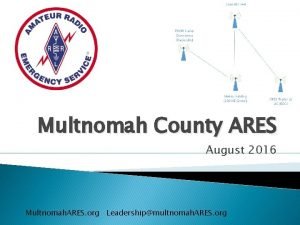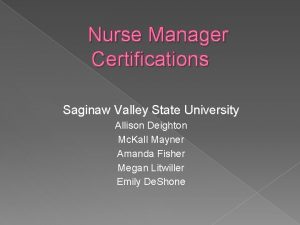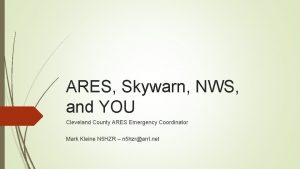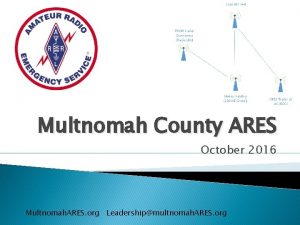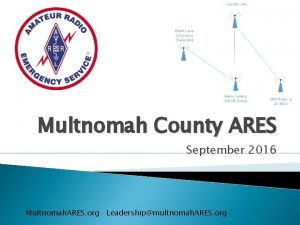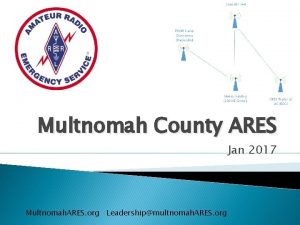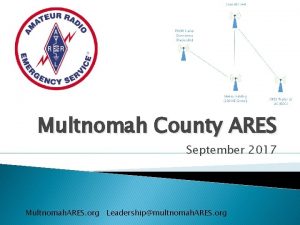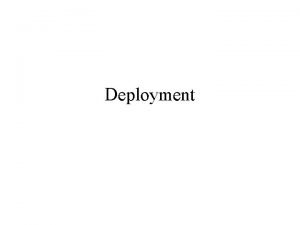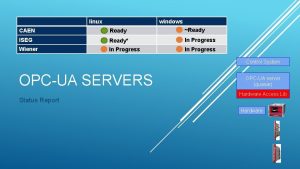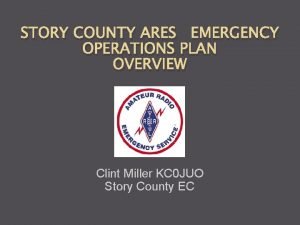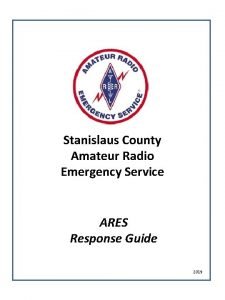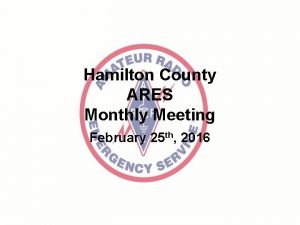PREPARE FOR DEPLOYMENT Saginaw County ARES Topics Ready



























- Slides: 27

PREPARE FOR DEPLOYMENT Saginaw County ARES

Topics � Ready Kit Idea List � Radios and Accessories � Personal Gear � Information � Operating Supplies � Sub-Dividing your Kits � When you Arrive

Ready Kits

Ready Kits The last thing you want to do when a call for assistance comes is think of and pack all the items you might need. An experienced emergency responder should know how important it is to keep a kit of the items they need ready to go at a moment's notice. This is often called a "ready kit" or “jump kit”. Without a ready kit, you will almost certainly leave something important at home, or bring items that will not do the job. Here a few basic questions you will need to answer:

Ready Kits � � � � � Which networks will you need to join, and what equipment will you need to do so? Will you need to be able to relocate quickly, or can you bring a ton of gear? Will you be on foot, or near your vehicle? Is your assignment at a fixed location or will you be mobile? How long might you be deployed - less than 48 hours, up to 72 hours, or even a week or more? Will you be in a building with reliable power and working toilets, or in a tent away from civilization? What sort of weather or other conditions might be encountered? Where will food and water come from? Are sanitary facilities available? Will there be a place to sleep? Do you need to plan for a wide variety of possible scenarios, or only a few?

Ready Kits � Most people seem to divide ready kits into two categories: ◦ one for deployments under 48 hours, ◦ and one for up to 72 hours. For deployments longer than 72 hours, many people will just add more of the items that they will use up, such as clothing, food, water, and batteries. Others may add a greater range of communication options and backup equipment as well. � You might want to keep a list with your “ready kit” of items that have a short shelf life that you would not want to have packed at all times. You might want prescriptions, batteries, and other items not pre-packed but have them on a list as a reminder of items to be added will help to keep from forgetting them at the last minute. �

Ready Kit Idea List

Ready Kit Idea List � Something to put it in -- one or more backpacks, suitcases, plastic storage tubs, etc. � Package individual items in zip lock bags or plastic kitchen containers � Label ALL your equipment with your name, call sign, etc.

Radios and Accessories

Radios and Accessories � Handheld VHF or dual-band radio (some people also like to bring a spare) � Spare rechargeable batteries for handhelds � Alkaline battery pack for handhelds � Alkaline batteries � Speaker mic and earphone for handhelds � Battery chargers, AC and DC for handhelds � Mobile VHF or dual-band radio � HF radio � Multi-band HF antenna, tuner, heavy parachute cord

Radios and Accessories � Gain antennas and adapters (roll-up J-Pole, mobile magnetic mount, etc. ) � Coaxial feed lines, jumpers � Ground rod, pipe clamp, and wire � AC power supplies for VHF, UHF mobile and HF radios, accessories � Large battery source for VHF/UHF mobile and HF radios, with charger � All related power, data, audio, and RF cables and adapters � Small repair kit: hand tools, multi-meter, connectors, adapters, fuses, key parts, soldering iron and solder.

Radios and Accessories � Materials for improvisation: ◦ wire, connectors, small parts, insulators, duct tape, etc. � Photocopies of manuals for all equipment � Headphones, for noisy areas and privacy � Specialized gear for packet, ATV or other modes � Multi-band scanner, weather radio � Personal cell phone, spare batteries and chargers � Pencils, legal pads, pencil sharpener

Personal Gear

Personal Gear � Clothing for the season, weather, and length of deployment � Toilet kit: ◦ soap, razor, deodorant, comb, toilet paper � Foul weather or protective gear, warm coats, hats, etc. as needed � Sleeping bag, closed-cell foam pad, pillow, ear plugs � High energy snacks � Bug Spray

Personal Gear � Easily prepared dried foods that will store for long periods � Eating and cooking equipment if needed � Water containers, filled before departure � First aid kit, personal medications and prescriptions for up to one week � Money, including a large quantity of quarters for vending machines, tolls, etc. � Telephone calling card

Operating Supplies

Operating Supplies � Outgoing message forms or sheets to compose messages (ICS-213, Radio. Gram) � Incoming message forms (ICS-213, Radio. Gram) ◦ Some operators copy the message onto scratch paper, and then transcribe it cleanly onto the incoming message form. ◦ Some groups use one form for both incoming and outgoing messages. � Log sheets (ICS-214) � Standard forms used by the served agency ◦ ICS-213, ICS-214, ICS-205 A, Radio. Gram

Operating Supplies � Letter or legal notepads � Sticky notes � Paper clips, binder clips and rubber bands � Blank envelopes � Pens, Pencils, Highlighter

Sub-Dividing your Kits

Sub-Dividing your Kits You may want to divide your ready kit into smaller packages. Here are some ideas: � Quick deployment kit: ◦ hand-held radio kit, personal essentials, in a large daypack � VHF/UHF, HF kits for fixed locations � Accessory and tool kit � Emergency power kit � Short and long term personal kits in duffel bags � Field kitchen and food box in plastic storage tubs � Field shelter kit (tents, tarps, tables, chairs, battery/gas lights) in plastic storage tubs

When you Arrive

When you Arrive When the time comes, you need to know where to go, and what to do. Having such information readily available will help you respond more quickly and effectively. It will not always be possible to know these things in advance, particularly if you do not have a specific assignment. Answering the following basic questions may help.

When you Arrive � Which frequency should you check in on initially? Is there a "backup" frequency? � If a repeater is out of service, which simplex frequency is used for the net? � Which nets will be activated first? � Should you report to a pre-determined location or will your assignment be made as needed?

When you Arrive One of the first things after arriving is to become familiar with your location. � You should make a note of any fire exits, or escape routes. Depending on the situation this could be invaluable information in time of need. Note the names and positions of those of authority at your location. � You may need this information when filling out message forms and documents.

Summary � Decide on what Go-Kits you need to have. � Keep your kits together and ready to go. � Keep a list of what you might need to add depending on the deployment time. � Sub-divide to make things easier.

Questions?

Credits � Waller County ARES, Christine Smith, N 5 CAS
 Stay ready to keep from getting ready
Stay ready to keep from getting ready Monroe county ares
Monroe county ares Multnomah county ares
Multnomah county ares Saginaw valley state university nursing
Saginaw valley state university nursing Saginaw sonar
Saginaw sonar Ready set kindergarten pinellas county
Ready set kindergarten pinellas county Bästa kameran för astrofoto
Bästa kameran för astrofoto Dikt med fri form
Dikt med fri form Presentera för publik crossboss
Presentera för publik crossboss Elektronik för barn
Elektronik för barn Nationell inriktning för artificiell intelligens
Nationell inriktning för artificiell intelligens Tack för att ni har lyssnat
Tack för att ni har lyssnat Allusion example
Allusion example Opłata dla charona
Opłata dla charona Shivaismen
Shivaismen Personlig tidbok fylla i
Personlig tidbok fylla i Tack för att ni har lyssnat
Tack för att ni har lyssnat What is the ares
What is the ares Ares 5
Ares 5 Mat för unga idrottare
Mat för unga idrottare Sju för caesar
Sju för caesar Treserva lathund
Treserva lathund Nyckelkompetenser för livslångt lärande
Nyckelkompetenser för livslångt lärande Ares god of war characteristics
Ares god of war characteristics What is aphrodite's strengths and weaknesses
What is aphrodite's strengths and weaknesses Toppslätskivling effekt
Toppslätskivling effekt We take a zebra to vegas
We take a zebra to vegas Densitet vatten
Densitet vatten


